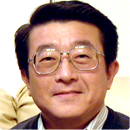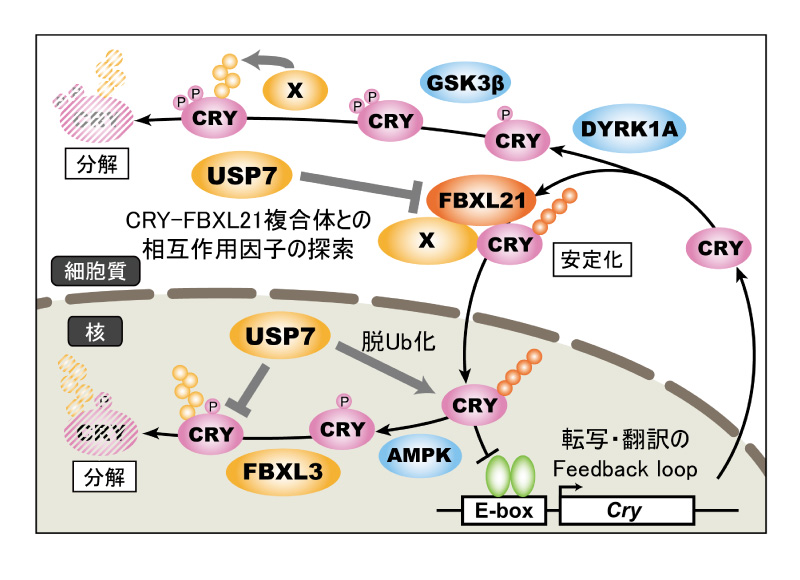正確な24時間リズムを生み出す時計タンパク質の安定化と分解のメカニズム

研究概要:
環境条件を一定にしても維持される約24時間周期の生物学的変動は概日リズムと呼ばれ、概日時計という体内の計時システムによって制御されることが知られている。哺乳類においては、PerとCry遺伝子の転写が自らの翻訳産物によって負にフィードバック制御され、時計振動の本体である24時間周期の転写リズムが生まれる。二つのCry遺伝子にコードされるC RY1とCRY2の機能の違いは不明だが、いずれもPERタンパク質に比べてはるかに強い転写抑制活性をもつ。さらにCRY1とCRY2のタンパク質量や細胞内の局在は一日を通してダイナミックに変化し、これが厳密に制御されなければ時計機能は破綻する。本研究は、サーカディアンリズスムの主役とも言えるCRYタンパク質のダイナミックな量的制御の徹底的な理解を目指し、CRYを安定化に導くE3リガーゼであるFBXL21を含む複数のユビキチン化・脱ユビキチン化酵素によるユビキチン-ネットワークの全貌を解明する。また、概日時計の時刻情報を伝達する出力系転写因子DBPのタンパク質レベルが顕著な日周変動することに着目し、この転写因子の安定性制御機構に迫る。
関連する代表的な論文:
- Kon, N. Yoshikawa, T., Honma, S., Yamagata, Y., Yoshitane, H., Shimizu, K., Sugiyama, Y., Hara, C., Kameshita, I., Honma, H., and Fukada, Y. (2014) CaMKII is essential for the cellular clock and coupling between morning and evening behavioral rhythms. Genes Dev. 28, 1101-1110.
- Hirano, A., Kurabayashi, N., Nakagawa, T., Shioi, G., Todo, T., Hirota, T., and Fukada, Y. (2014) In vivo role of phosphorylation of Cryptochrome2 in the mouse circadian clock. Mol. Cell. Biol. 34, 4464-4473.
- Yoshitane, H., Ozaki, H., Terajima, H., Du, N.-H. Suzuki, Y., Fujimori, T., Kosaka, N., Shimba, S., Sugano, S., Takagi, T., Iwasaki, W., and Fukada, Y. (2014) CLOCK-controlled polyphonic regulations of circadian rhythms through canonical and non-canonical E-boxes. Mol. Cell. Biol. 34, 1776-1787.
- Pekovic-Vaughan, V., Gibbs, J., Yoshitane, H., Yang, N., Pathiranage, D., Guo, B., Sagami, A., Taguchi, K., Bechtold, D., Loudon, A., Yamamoto, M., Chan, J., van der Horst, G.T.J., Fukada, Y. and Meng, Q.-J. (2014) The circadian clock regulates rhythmic activation of the NRF2/glutathione-mediated antioxidant defense pathway to modulate pulmonary fibrosis. Genes Dev. 28, 548-560.
- Gossan, N., Zhang, F., Guo, B. Jin, D., Yoshitane, H., Yao, A., Glossop, N., Zhang, Y.Q., Fukada, Y., and Meng, Q.-J. (2014) The E3 ubiquitin ligase UBE3A is an integral component of the molecular circadian clock through regulating the BMAL1 transcription factor. Nucleic Acids Res. 42, 5765-5775.
- Hirano, A., Yumimoto, K., Tsunematsu, R., Matsumoto, M., Oyama, M., Kozuka-Hata, H., Nakagawa, T., Lanjakornsiripan, D., Nakayama, K.I., and Fukada, Y. (2013) FBXL21 regulates oscillation of the circadian clock through ubiquitination and stabilization of cryptochromes. Cell 152, 1106-1118.
- Yoshitane, H., Honma, S., Imamura, K., Nakajima, H., Nishide, S., Ono, D., Kiyota, H., Shinozaki, N., Matsuki, H., Wada, N., Doi, H., Hamada, T., Honma, K., and Fukada Y. (2012) JNK regulates the photic response of the mammalian circadian clock. EMBO Rep. 13, 455-461
- Hatori, M., Hirota, T., Iitsuka, M., Kurabayashi, N., Haraguchi, S., Kokame, K., Sato, R., Nakai, A., Miyata, T., Tsutsui, K., and Fukada, Y. (2011) Light-dependent and circadian clock-regulated activation of sterol regulatory element-binding protein, X-box-binding protein 1 and heat shock factor pathways. Proc. Natl. Acad. Sci. USA 108, 4864-4869.
- Kurabayashi, N., Hirota, T., Sakai, M., Sanada, K., and Fukada, Y. (2010) DYRK1A and GSK-3β: A dual kinase mechanism directing proteasomal degradation of CRY2 for circadian timekeeping. Mol. Cell. Biol. 30, 1757-1768.
- Kon, N., Hirota, T., Kawamoto, T., Kato, Y., Tsubota, T., and Fukada, Y. (2008) Activation of TGF-β/activin signalling resets the circadian clock through rapid induction of Dec1 transcripts. Nat. Cell Biol. 10, 1463-1469.









